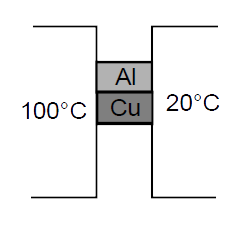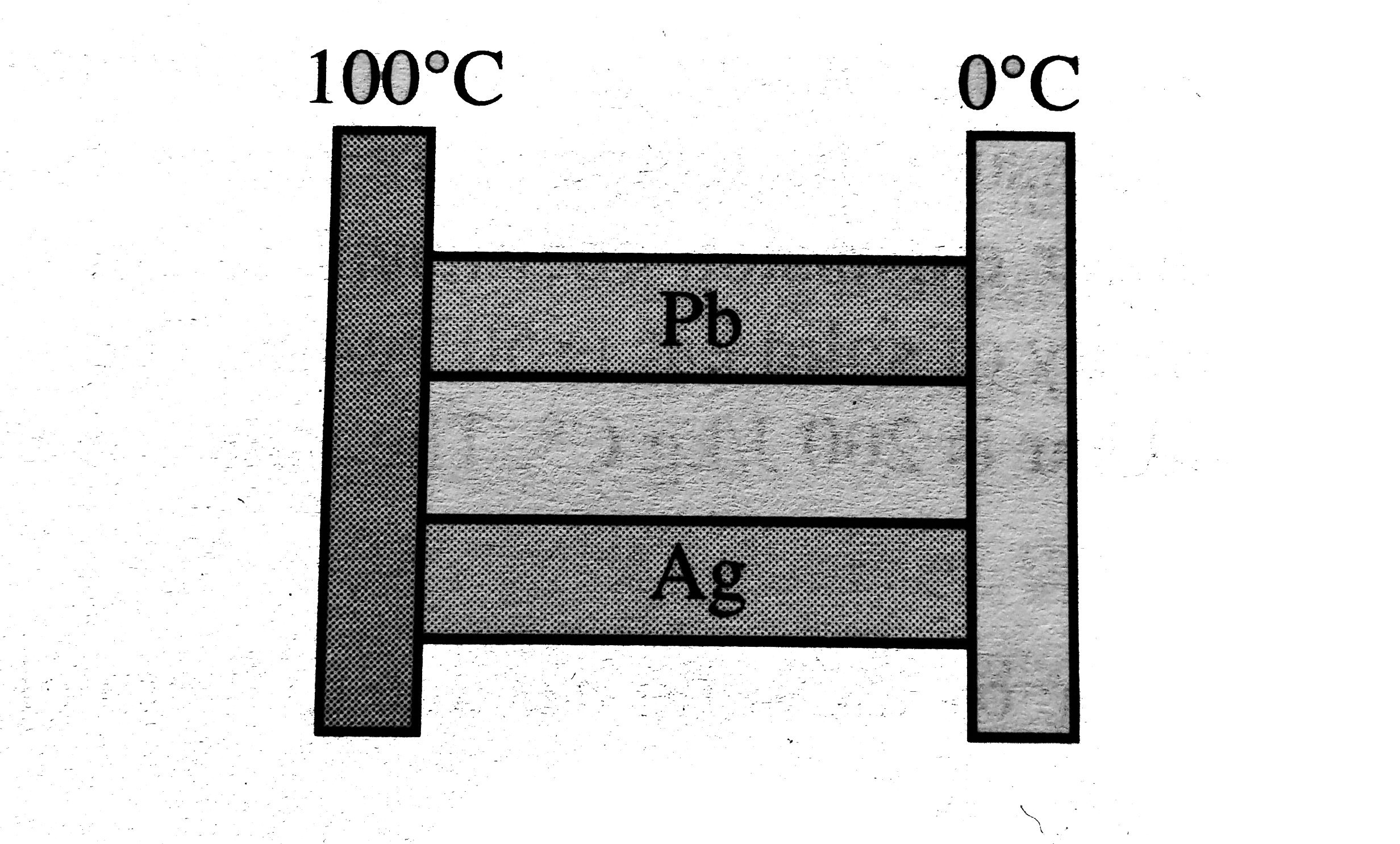
Two insulated metal bars each of length 5 cm and rectangular cross section with sides 2 cm and 3 cm are wedged between two walls, one held at 100∘C and the other at 0∘C. The bars are made of lead and silver. Kpb=350W/mK,KAg=425W/mK.
Total thermal current through the two bar system is
210 W
420 W
510 W
930 W
The correct Answer is:D
Resistance of silver bar
RAg=(lAg))KAgAAg=5×10−2425×6×10−4
=10085×6=2017×6=1051KW
Thermal current through silver bar
IAg=ΔTRAg=100×5110=510W
Total thermal current Ipb+IAg=930W
Topper's Solved these Questions
- CALORIMETRYBook:CENGAGE PHYSICSChapter:CALORIMETRYExercise:Integer
Explore 8 Videos
- CALORIMETRYBook:CENGAGE PHYSICSChapter:CALORIMETRYExercise:Solved Example
Explore 13 Videos
- CALORIMETRYBook:CENGAGE PHYSICSChapter:CALORIMETRYExercise:Multiple Correct
Explore 25 Videos
- BASIC MATHEMATICSBook:CENGAGE PHYSICSChapter:BASIC MATHEMATICSExercise:Exercise 2.6
Explore 20 Videos
- CENTRE OF MASSBook:CENGAGE PHYSICSChapter:CENTRE OF MASSExercise:INTEGER_TYPE
Explore 1 Video
Similar Questions
Two metal cubes with 3 cm-edges of copper and aluminium are arranged as shown in figure. (KCU=385W/m−K,KAL=209W/m−K)
The total thermal current from one reservoir to the other is :

View SolutionA bar of copper of length 75 cm and a bar of steel of length 125 cm are joined together end to end . Both are of circular cross - section with diameter 2 cm . The free ends of the copper and steel bars are maintained at 100∘C and 0∘C respectively . The surface of the bars are thermally insulted . What is the temperature of the copper - steel junction ? What is the heat transmitted per unit time across the junction ? Thermal conductivty of copper 9.2×10−2kcalm−1∘C−1s−1 and that of steel is 1.1×10−2kcalm−1s−1(∘)C−1.
View Solution
Knowledge Check

Two insulated metal bars each of length 5 cm and rectangular cross section with sides 2 cm and 3 cm are wedged between two walls, one held at 100∘C and the other at 0∘C. The bars are made of lead and silver. Kpb=350W/mK,KAg=425W/mK.
Thermal corrent through lead bar isA210 WB420 WC510 WD930 W
Two insulated metal bars each of length 5 cm and rectangular cross section with sides 2 cm and 3 cm are wedged between two walls, one held at 100∘C and the other at 0∘C. The bars are made of lead and silver. Kpb=350W/mK,KAg=425W/mK.
Equevalent thermal resistence of the two bar system isA0.1KWB0.23KWC0.19WWD0.42KWTwo smooth sphere each of radius 5cm and weight W rest one on the other inside a fixed smooth cylinder of radius 8cm. The reaction between the sphere and the vertical side of the cylinder are:
 AW/4 and 3W/4BW/4 and W/4C3W/4 and 3W/4DW and W
AW/4 and 3W/4BW/4 and W/4C3W/4 and 3W/4DW and W
A metal bar of length L and area of cross-section A is rigidly champed between two walls. The Young's modulus of its material is Y and the coefficient of linear expansion is α. The bar is heated so that its temperature is increased by θ∘C. Find the force exerted at the ends of the bar.
View SolutionA copper rod 2 m long has a circular cross-section of radius 1 cm. One end is kept at 100∘C and the other at 0∘C. The surface is insulated so that negligible heat is lost through the surface. In steady state, find
(a) the thermal resistance of the bar
(b) the thermal current H
(c) the temperature gradient dTdx and
(d) the temperature at a distance 25 cm from the hot end.
Thermal conductivity of copper is 401 W/m−K.
View SolutionA metal frame of total length 50cm ad croos-sectional area 0.20cm2 froms five sides of a regular hexagon. The free ends are maintained at 20∘C and 40∘C. Find the rate of heat flow through a cross-section of the frame (K=50W/m∘C)
View SolutionFigure shows a steel rod joined to a brass eod. Each of the rods has length of 31cm and area of cross-section 0.20cm2. The junction is maintained at a constant temperature 50∘C and the two ends are maintained at 100∘C. The amount of heat taken out from the cold junction in 10 minutes after the steady state is reached in n×102J. Find 'n' the thermal conductivities are Ksteel=46W/m−∘C and Kbrass=109W/m−∘C.

View SolutionA rod of negligible heat capacity has a length of 50 cm, area of cross section 5cm2 and thermal conductivity 500 W/m∘C. The temperature of one end is maintained at 0∘C and that fo the other end is slowly and linearly varied from 0∘C to 60∘C in 20 min. Assuming no heat loss through the lateral side, the total heat transmitted throught he rod in 20 minutes is
View Solution

